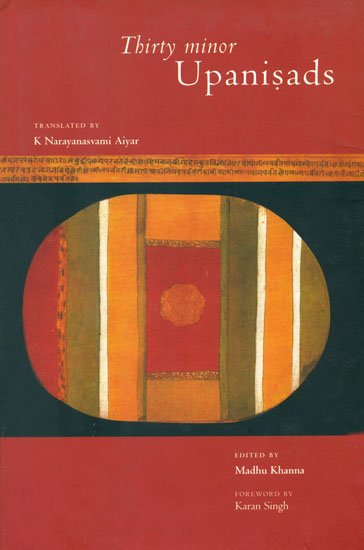Thirty minor Upanishads
by K. Narayanasvami Aiyar | 1914 | 95,228 words
This book contains the English translation of thirty minor Upanishads.—Fourteen belonging to Vedanta, two are categorised as Physiological, three are Mantra, two are Sannyasa and the remaining nine are categorised as Yoga-Upanishads. These Upanishads are properly defined as the Aranya-portion of the Vedas (most ancient Hindu scriptures) and are so-...
Subala Upanishad of Shukla-yajurveda, Chapter II
"From apāna came Niṣādas, Yakṣas, Rākṣasas, and Gandharvas. From (His) bones, arose the mountains. From His hairs arose the herbs and the trees. From His forehead, Rudra was born through His anger. The breath of this great Being became the Ṛgveda, Yajurveda, Sāmaveda, Atharvaveda, Śīkṣā (the science of the proper pronunciation and articulation of sounds), Kalpa (the science of methodology), Vyākaraṇa (grammar), Nirukta (glossarial explanation of obsolete and other terms in Vedas), Chandas (prosody or vedic metre), Jyotiṣa (astronomy), Nyāya (logic), Mīmāmsā (including rituals and vedānta), Dharmaśāstras, commentaries, glosses and all beings. This Ātmā (or the Self of Puruṣa) is Hiraṇyajyotis (or golden or effulgent Light) into which all the universe is absorbed. He divided Ātmā (his Self) into two moieties; out of one moiety, the woman was created; and out of the other, man. Having become a Deva, He created the Devas. Having become a Ṛṣi, He created the Ṛṣis; also He created Yakṣas, Rākṣasas, Gandharvas, wild and domestic beasts and others such as cows, bulls, mares and horses, she-asses and asses and Viśvambhara (the Supporter) and Viśvambharā (the earth). Becoming Vaiśvānara (fire) at the end (of creation), He burnt up all objects. Then (in dissolution), pṛthivī was absorbed in āpas, āpas in agni, agni in vāyu, vāyu in ākaś, ākaś in indriyas (organs), indriyas into tanmātras (rudimentary properties), tanmātras into bhūtādi, bhūtādi into mahat, mahat into avyakta, avyakta into akṣara (the indestructible), akṣara into Lamas (darkness). And Lamas becomes one with the supreme Lord. And then there is neither Sat nor asat, nor Sat-asat. This is the teaching of Nirvāṇa and this is the teaching of the Vedas. Yea, This is the teaching of the Vedas."
